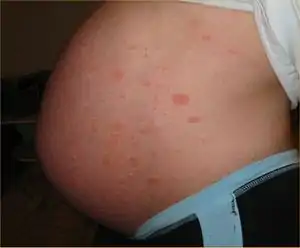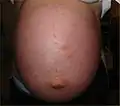Pruritic urticarial papules and plaques of pregnancy
Pruritic urticarial papules and plaques of pregnancy (PUPPP), known in United Kingdom as polymorphic eruption of pregnancy (PEP),[1] is a chronic hives-like rash that strikes some women during pregnancy. It presents no long-term risk for either the mother or unborn child despite frequently severe pruritus. PUPPP frequently begins on the abdomen and spreads to the legs, feet, arms, chest, and neck.[2]
| PUPPP | |
|---|---|
 | |
| Left side view of abdomen |
Papules and plaques usually first appear on the abdomen (although not on the umbilicus/belly button) and often spread to the legs, chest, underarms, etc. The face is usually also spared and does not seem to become affected.
Skin distension (stretching) is thought to be a possible trigger for PUPPP as it most commonly affects primigravida (women in their first pregnancy), women with large fundal measurements and/or those who are carrying large babies or multiples. The papules and plaques often first appear within stretch marks.
Certain studies reveal that this condition is more frequent in women carrying boys, although no formal research has been conducted. Statistics cite that 70% of PUPPP sufferers deliver boys.
PUPPP occurs in about 1 in every 200 pregnancies.[3]
Cause
The cause of the condition is generally unknown.[1] This skin condition occurs mostly in first pregnancies (primigravida), in the third trimester and is more likely with multiple pregnancies (more so with triplets than twins or singletons).[4][5]
Other than additional associations with hypertension and induction of labour, there are no observed difference in the outcome of the pregnancy for mothers or babies.[6]
Diagnosis
 Front view of abdomen
Front view of abdomen Side view of abdomen
Side view of abdomen Feet and ankle view
Feet and ankle view
Treatment
Soothing mild cases during pregnancy consists mainly of the application of topical moisturising creams or aqueous/emollient ointments. Class I or II corticosteroid creams and ointments are used in more aggressive cases, and oral (systemic) corticosteroids can be used to treat very severe cases—although the benefits of a pregnant woman's ingesting high-potency corticosteroids must be weighed carefully against possible (and mostly unknown) risks to the developing fetus or fetuses. Rarely, in unusually persistent and distressing cases, some women have had their labor induced as soon as they are considered to be at term (37 weeks).[7]
Antihistamine tablets may be prescribed to provide relief from the itch, although they are generally considered much less effective than corticosteroid treatments,[8] and may decrease itching through blocking histamine release as well as improving sleep quality.
Pine tar soap/body wash can bring relief as can keeping the skin chilled such as through a cold shower or iced cloths.
In the majority of cases, PUPPP resolves spontaneously within a week of delivery. However, a few women continue to experience symptoms long into the postpartum period.
See also
- Intrahepatic cholestasis of pregnancy
- List of cutaneous conditions
References
- Matz H, Orion E, Wolf R (Mar–Apr 2006). "Pruritic urticarial papules and plaques of pregnancy: polymorphic eruption of pregnancy (PUPPP)". Clin Dermatol. 24 (2): 105–8. doi:10.1016/j.clindermatol.2005.10.010. PMID 16487883.
- Tunzi M, Gray GR (January 2007). "Common skin conditions during pregnancy". Am Fam Physician. 75 (2): 211–8. PMID 17263216.
- Elling, SV; McKenna, P; Powell, FC (September 2000). "Pruritic urticarial papules and plaques of pregnancy in twin and triplet pregnancies". J Eur Acad Dermatol Venereol. 14 (5): 378–81. doi:10.1046/j.1468-3083.2000.00026.x. PMID 11305379. S2CID 44551742.
- Pruritic Urticarial Papules and Plaques of Pregnancy derm/351 at eMedicine
- Brzoza Z, Kasperska-Zajac A, Oleś E, Rogala B (Jan–Feb 2007). "Pruritic urticarial papules and plaques of pregnancy". J Midwifery Women's Health. 52 (1): 44–8. doi:10.1016/j.jmwh.2006.09.007. PMID 17207750.
- Ohel I, Levy A, Silberstein T, Holcberg G, Sheiner E (May 2006). "Pregnancy outcome of patients with pruritic urticarial papules and plaques of pregnancy". J Matern Fetal Neonatal Med. 19 (5): 305–8. doi:10.1080/14767050600590573. PMID 16753771. S2CID 20129348.
- De G, De G (January 2002). "Pruritic urticarial papules and plaques of pregnancy: an unusual case" (PDF). J Am Osteopath Assoc. 102 (1): 44–6. PMID 11837341. Archived from the original (PDF) on 2007-09-27.
- Pruritic Urticarial Papules and Plaques of Pregnancy~treatment at eMedicine
External links
| Classification | |
|---|---|
| External resources |